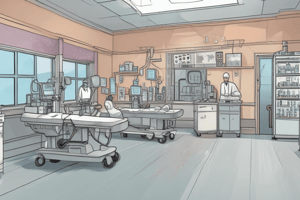Podcast
Questions and Answers
Quin és un dels components claus de la seguretat del pacient que té com a objectiu prevenir les infeccions associades a l'atenció sanitària (HAIs)?
Quin és un dels components claus de la seguretat del pacient que té com a objectiu prevenir les infeccions associades a l'atenció sanitària (HAIs)?
- Canvis de catèter
- Rentat de mans (correct)
- Injeccions intramusculars
- Totes les anteriors
Quina mesura de seguretat s'ha implementat per evitar errors en la medicació durant l'etapa de prescripció o ordre?
Quina mesura de seguretat s'ha implementat per evitar errors en la medicació durant l'etapa de prescripció o ordre?
- No seguir cap procés de control
- Prescriure medicaments sense supervisió
- Canviar la dosi sense confirmar
- Revisar les ordres de medicaments dues vegades (correct)
Quina pràctica s'ha posat en marxa per assegurar la identificació correcta del pacient?
Quina pràctica s'ha posat en marxa per assegurar la identificació correcta del pacient?
- No verificar mai la identitat del pacient
- Etiquetar totes les medicacions, fins i tot les que estan en una geringa (correct)
- No etiquetar els medicaments
- Confirmar la identitat del pacient de pel·lícula
Quin tipus de comunicació es considera vital per a la seguretat del pacient en l'àmbit sanitari?
Quin tipus de comunicació es considera vital per a la seguretat del pacient en l'àmbit sanitari?
Què implica crear una cultura de seguretat del pacient en un entorn sanitari?
Què implica crear una cultura de seguretat del pacient en un entorn sanitari?
Què és un 'casi incidente' en relació amb la seguretat del pacient?
Què és un 'casi incidente' en relació amb la seguretat del pacient?
En quina situació s'aplicaria la tipificació de risc en el marc de la seguretat del pacient?
En quina situació s'aplicaria la tipificació de risc en el marc de la seguretat del pacient?
Quin és l'objectiu principal de la Classificació Internacional de Seguretat del Pacient (CISP) de l'OMS?
Quin és l'objectiu principal de la Classificació Internacional de Seguretat del Pacient (CISP) de l'OMS?
Quina és una mesura correctiva adequada després d'un error en l'administració d'un medicament a un pacient equivocat?
Quina és una mesura correctiva adequada després d'un error en l'administració d'un medicament a un pacient equivocat?
En quin cas es consideraria que hi ha un 'Risc Màxim' en relació amb la seguretat del pacient?
En quin cas es consideraria que hi ha un 'Risc Màxim' en relació amb la seguretat del pacient?
Flashcards are hidden until you start studying
Study Notes
Patient Safety: Enhancing Quality of Care through Continuous Improvement
Introduction
Patient safety is a critical aspect of healthcare that aims to prevent medical errors and minimize their adverse impacts on patients. Ensuring patient safety involves various subtopics, including medical errors, infection control, medication safety, patient identification, and communication in healthcare. This article will delve into these subtopics and explore the measures taken to enhance patient safety and improve the quality of care.
Medical Errors
Medical errors refer to preventable events that may cause or lead to inappropriate medication use or patient harm while the medication is in the patient. These errors are most common at the ordering or prescribing stage and include prescribing the wrong medication, route, dose, or frequency. The National Coordinating Council for Medication Error Reporting and Prevention defines a medication error as any preventable event that may cause or lead to inappropriate medication use or patient harm while the medication is in the patient.
To reduce the risk of medical errors, healthcare professionals must improve communication and understanding among multiple providers or between the provider and patient. The teach-back method, where the healthcare provider rephrases the message until the patient and caregiver demonstrate clear understanding, has been positively correlated with improved patient adherence and outcomes.
Infection Control
Infection control is a key component of patient safety, aiming to prevent healthcare-associated infections (HAIs). HAIs can lead to significant morbidity, mortality, and increased healthcare costs. To prevent infections, healthcare organizations have implemented measures such as hand washing, post-operative infection antibiotics, catheter changes, and central line precautions.
Medication Safety
Medication safety is crucial for patient safety, as errors can lead to adverse events such as medication errors at the ordering or prescribing stage. To ensure medication safety, healthcare providers should implement measures such as double-checking medication orders, using medication safety tools, and conducting regular audits to identify and address potential issues.
Patient Identification
Patient identification is essential to ensure that patients receive the appropriate care and treatment. To prevent misidentification, healthcare organizations have implemented measures such as confirming patient identity in at least two ways and labeling all medications, even those in a syringe.
Communication in Healthcare
Effective communication between healthcare providers and patients is vital for patient safety. Poor communication can contribute to medication errors and adverse events. Health information technology (HIT) has been identified as a powerful avenue for connecting directly with patients, providing them with access to their electronic health records, and soliciting patient-reported outcomes.
Enhancing Patient Safety Culture
Creating a patient safety culture involves fostering a supportive environment that encourages collaboration and open communication among healthcare teams. Training programs and ongoing education are critical for promoting patient safety and minimizing misunderstandings. A patient safety culture can lead to a higher standard of care, improved overall quality of care, and reduced medical errors and adverse events.
Conclusion
Enhancing patient safety is a continuous process that requires ongoing efforts from healthcare organizations and professionals. By focusing on the subtopics of medical errors, infection control, medication safety, patient identification, and communication in healthcare, we can work towards creating a safer and more effective healthcare system.
Studying That Suits You
Use AI to generate personalized quizzes and flashcards to suit your learning preferences.




